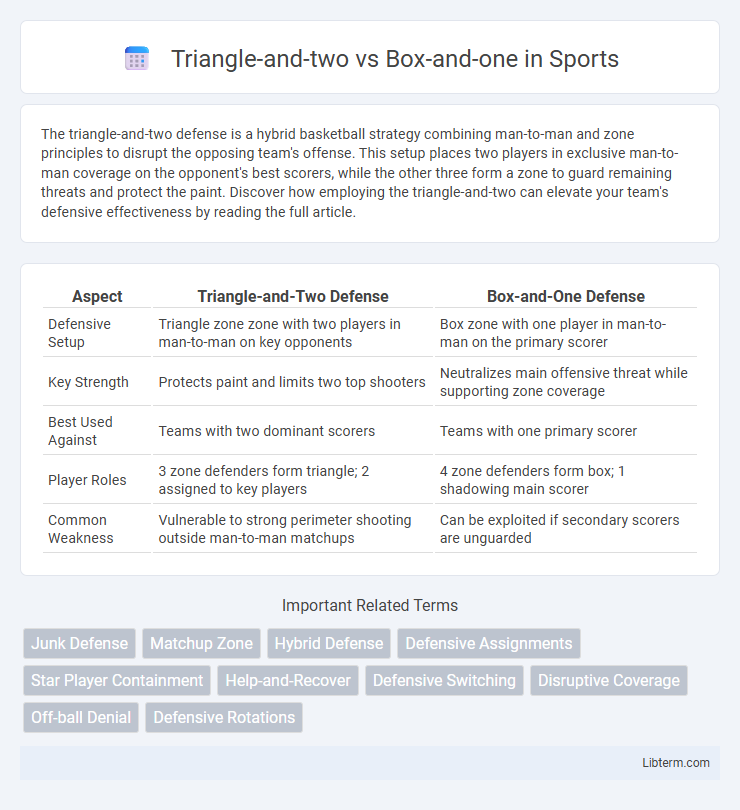The triangle-and-two defense is a hybrid basketball strategy combining man-to-man and zone principles to disrupt the opposing team's offense. This setup places two players in exclusive man-to-man coverage on the opponent's best scorers, while the other three form a zone to guard remaining threats and protect the paint. Discover how employing the triangle-and-two can elevate your team's defensive effectiveness by reading the full article.
Table of Comparison
| Aspect | Triangle-and-Two Defense | Box-and-One Defense |
|---|---|---|
| Defensive Setup | Triangle zone zone with two players in man-to-man on key opponents | Box zone with one player in man-to-man on the primary scorer |
| Key Strength | Protects paint and limits two top shooters | Neutralizes main offensive threat while supporting zone coverage |
| Best Used Against | Teams with two dominant scorers | Teams with one primary scorer |
| Player Roles | 3 zone defenders form triangle; 2 assigned to key players | 4 zone defenders form box; 1 shadowing main scorer |
| Common Weakness | Vulnerable to strong perimeter shooting outside man-to-man matchups | Can be exploited if secondary scorers are unguarded |
Introduction to Junk Defenses in Basketball
Junk defenses in basketball, including Triangle-and-Two and Box-and-One, are specialized strategies used to disrupt key offensive players. Triangle-and-Two employs three players in a zone formation while two defenders play tight man-to-man defense on the opponent's best scorers. Box-and-One features four players forming a box zone around the paint, with one defender shadowing the top offensive threat, aiming to neutralize scoring threats and force less skilled players to take shots.
Understanding the Triangle-and-Two Defense
The Triangle-and-Two defense combines a three-player zone forming a triangle with two players in man-to-man coverage, designed to contain a team's best perimeter scorers while protecting the paint. This strategy contrasts with the Box-and-One, which uses four players in a box zone and one defender shadowing a specific opponent, emphasizing individual shutdown. Understanding the Triangle-and-Two involves recognizing how it disrupts perimeter passing lanes and forces offenses into contested mid-range shots or interior scoring under pressure.
Overview of the Box-and-One Defense
The Box-and-One defense features four players forming a box-shaped zone around the paint while a fifth player guards the opposing team's best perimeter scorer one-on-one. This hybrid scheme combines man-to-man pressure with zone coverage to disrupt offensive rhythm and limit outside shooting. By isolating a key threat, the Box-and-One enhances defensive flexibility and forces opponents to rely on secondary options.
Key Differences between Triangle-and-Two and Box-and-One
Triangle-and-two defense features two defenders tightly guarding the opposing team's best perimeter players, while three others form a zone to protect the paint. Box-and-one defense assigns four players to a box-shaped zone around the key, focusing on interior defense, and one defender to tightly shadow a single offensive threat. The key difference lies in how defensive responsibilities shift between man-to-man and zone coverage, with Triangle-and-two emphasizing perimeter pressure and Box-and-one prioritizing interior containment.
Situations Best Suited for Triangle-and-Two
Triangle-and-two defense excels against teams with one dominant scorer and two strong shooters, effectively isolating the main threat while applying pressure on secondary shooters. It's best suited for situations where neutralizing a star player disrupts the opponent's offense, particularly in half-court settings with clear offensive roles. This defense also thrives when the team has versatile wing defenders capable of switching between man-to-man and zone responsibilities.
When to Use Box-and-One Defense
Box-and-one defense is most effective against a team featuring a dominant scorer who requires constant pressure, as it combines a box zone to protect the paint with a man-to-man shadow on the key threat. Use this approach when facing opponents with a single dynamic offensive player, allowing your defense to neutralize their impact without sacrificing overall team coverage. This strategy works best in situations where disrupting the primary scorer can significantly reduce the opponent's offensive efficiency.
Strengths and Weaknesses of Triangle-and-Two
Triangle-and-two defense excels in limiting dribble penetration by assigning two defenders to guard the opponent's key perimeter threats, enhancing perimeter pressure and disrupting outside shooting. Its weakness lies in vulnerability to backdoor cuts and interior scoring, as only one defender covers the paint, making it susceptible to teams with strong post players and effective off-ball movement. Effective communication and quick rotations are essential to compensate for these gaps and maintain defensive cohesion.
Pros and Cons of Box-and-One Defense
Box-and-one defense combines a solid box zone guarding four players with tight man-to-man coverage on a key opponent, allowing teams to neutralize prolific scorers effectively. This strategy demands intense communication and quick rotations to cover mismatches and prevent exploitation in the man coverage area, which can leave vulnerabilities if the defense collapses or the ball moves quickly. While the Box-and-one can disrupt a star player's rhythm, its success heavily depends on the defenders' discipline and can struggle against versatile offenses that exploit gaps in the lone man-to-man defender's coverage.
Coaching Tips: Implementing Hybrid Defenses
Coaches should prioritize clear communication and role assignments when implementing hybrid defenses like Triangle-and-Two and Box-and-One to ensure effective perimeter pressure and interior containment. Emphasizing quick defensive rotations and man-to-man accountability within these zone principles maximizes disruption against high-scoring opponents. Consistent practice of switching strategies mid-game enhances team adaptability, improving overall defensive resilience.
Choosing the Right Defense for Your Team
Triangle-and-two defense combines zone principles with man-to-man coverage by assigning two defenders to mark the opposing team's best scorers, enhancing perimeter pressure and disrupting outside shooting. Box-and-one defense places four players in a box zone to control inside play while one defender shadows a key offensive threat, effectively neutralizing dominant scorers in isolation. Selecting the appropriate defense depends on your team's personnel strengths, the opponent's offensive tendencies, and the desired balance between interior protection and perimeter disruption.
Triangle-and-two Infographic

 libterm.com
libterm.com